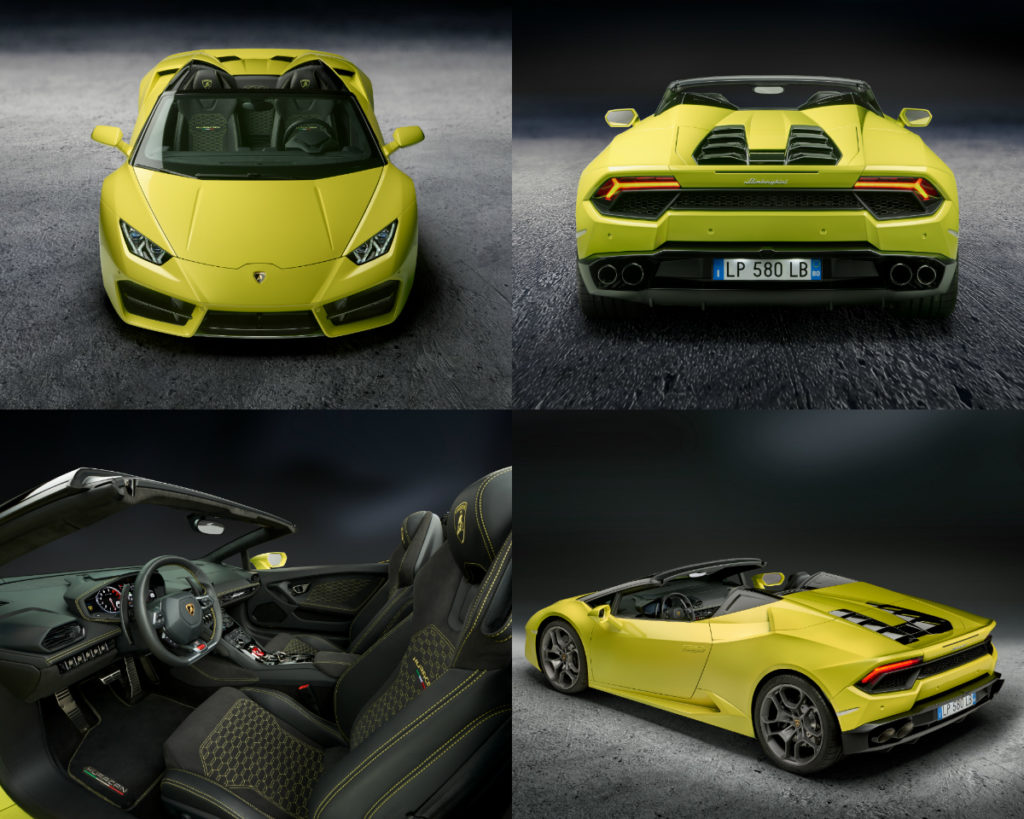 The front and rear of the car have been redesigned, with its dynamic good looks accented by the large front air intakes that direct cooling air and headwind to increase down pressure on the front axle. Pirelli P Zero tyres, exclusively developed for the rear-wheel-drive Huracan, sit on 19-inch Kari rims, while specially contoured steel brakes with aluminum brake disc pots assist in weight reduction and improved cooling. Inside, the cockpit features the latest Lamborghini Infotainment System II with a 12.3-inch hi-res TFT instrument panel.
The front and rear of the car have been redesigned, with its dynamic good looks accented by the large front air intakes that direct cooling air and headwind to increase down pressure on the front axle. Pirelli P Zero tyres, exclusively developed for the rear-wheel-drive Huracan, sit on 19-inch Kari rims, while specially contoured steel brakes with aluminum brake disc pots assist in weight reduction and improved cooling. Inside, the cockpit features the latest Lamborghini Infotainment System II with a 12.3-inch hi-res TFT instrument panel.
The latest addition to the Huracán family adopts the soft-top solution of a true Spyder, distinguishing the convertible from its coupe sibling through a unique profile, with roof both up and down. Opening and closing in just 17 seconds at speeds of up to 50km/h, the lightweight soft-top is efficiently stowed to maintain the Spyder’s perfect centre of gravity and highlight the dynamic design of the open supercar.
With the roof down, two distinctive fins rise out of the folding roof-casing to perfectly define the unique lines of the vehicle. Accenting the Huracan Spyder’s low, powerful appearance, the rear fins start at the seatbacks and continue the roofline to the rear, creating the Spyder’s flowing profile. The two fins contribute to optimising airflow through the engine compartment, which is covered by a slatted engine bonnet specific to the Spyder.
An integrated duct reduces turbulence in the headroom during open-top driving. With the soft-top either up or down, the driver can also electronically open the rear window, which functions as a windshield when up and highlights the V10 engine’s unique sound when down. Two removable lateral windguards dampen lateral aerodynamic noise in the cabin, permitting conversations even at high speeds.
As it does in the rear-drive Huracan coupe, the Spyder’s 5.2-litre V10 naturally aspirated, mid-mounted engine provides a maximum 580bhp power output at 8000rpm and 540Nm of torque at 6500rpm, with 75 percent of torque already available at 1000rpm. Acceleration from zero to 100km/h is achieved in 3.6 seconds, with a top speed of 319km/h.
Like the coupe, the newest Spyder promises the thrill of two-wheel-drive dynamics, roof up or down. Weighing 1509kg dry, the RWD Huracán Spyder achieves a weight-to-power ratio of just 2.6kg per hp.
The RWD Huracán’s exceptionally stiff hybrid aluminum and carbon fibre chassis is complemented by springs and anti-roll bars on double wishbone suspension. The power management system of the rear-drive includes a specific steering setup and recalibrated stability and traction controls, connecting the driver as directly as possible with the road. Weight distribution is biased 40 percent towards the front and 60 percent towards the rear, reducing inertia on the front axle.
The Lamborghini Doppia Frizione (LDF) 7-speed dual-clutch transmission ensures the fastest gearchanges and includes “launch control” for maximum acceleration from a standing start. The electronic power steering and optional Lamborghini Dynamic Steering (LDS) are tuned specifically for the rear-drive Spyder, ensuring maximum agility and control in every driving condition, depending on driving mode and speed.
The rear-wheel-drive Huracan Spyder will be available in Lamborghini markets worldwide from January 2017, priced between the two- and four-wheel-drive coupe models and completing the core Huracan product range. 
Read our review of the four-wheel-drive Lamborghini Huracan Spyder.
Read our review of the rear-wheel-drive Lamborghini Huracan coupe.












